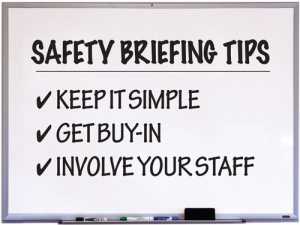Govt to rethink farm health and safety rules with practical reforms
Farmers are welcoming new Government proposals to make farm health and safety rules more practical and grounded in real-world farming.
 Keep it simple: clearly communicate risks to staff, involve your team and form a clear list together. It’s not about table-thumping meetings and reams of paper.
Keep it simple: clearly communicate risks to staff, involve your team and form a clear list together. It’s not about table-thumping meetings and reams of paper.
Onfarm injuries are at their highest in the beginning of spring — here's how you can prevent them.
Onfarm injuries cover a broad spectrum, from being crushed or bitten by animals, being trapped by stationary or moving objects or even hurt by explosions. Add to that, the second highest incidences of falls on the same level and muscular strains, this time of year is a dangerous time.
For any business, having staff away injured or sick at such a busy time, is likely to have a serious effect on productivity, while also increasing the likelihood of more stress on owners or workers as their workload increases to cover absentees.
Like all employers, farmers have a responsibility for their workers health and safety, and as part of that responsibility, should ensure that employees are actively involved in health and safety planning. Its important to understand that involving staff in H&S decisions for numerous reasons. Firstly, it helps address a wider range of issues that need addressing, more chance of evolving practical solutions, but importantly, achieving more engagement from teams and individuals.
Human nature is such, that people like working in places that value their opinions, and more so, for those businesses that actively try to look after their health and wellbeing. This perception also leads to the likelihood that staff are retained for longer, that itself means the business benefits from those employees’ experience and greater knowledge of the operation.
Getting workers to “buy into” safe practice needs to be kept simple-it shouldn’t be about table thumping meetings or reams of paper, as much more can be achieved at an informal morning “Smoko” with coffee and sausage rolls, although the waistlines may be in some danger. In real terms, the issue is about identifying and discussing the risks on your farm and how to manage them, because after all, there are no better people to know the farm, and manage those risks?
Farmers also need to be mindful that safety-related conversations don’t just happen at the start of the season, but become an ongoing topic, mindful that risks may change, maybe because of weather, the arrival of new plant or machinery, or even changing ground conditions. Farmers and their managers should strive to create a culture where workers aren’t afraid to speak up for fear of being shouted down or ridiculed when raising their concerns. Encourage everyone to report “near misses” and discuss solutions in a positive manner so the same things don’t happen again.
Think about investing in a whiteboard or if you’re on a budget, an old white shower lining for the Meeting Room or centralised area, so everyone can put up or list items of concern, and any near misses for discussion. It can also be used to list changing risks, but importantly it helps to reinforce a positive safety “buy-in”. Think about taking things further by producing a Farm Hazard Map, that is populated following a farm walk with staff, and useful to hand to farm visitors such as contractors.
Also make sure to give workers the power to identify risks, that might cause serious injury or death, while also encouraging them to confront any co-workers or visitors who they believe are at risk or aren’t abiding by the farm safety plan. But most of all, lead by example, by taking the lead in risk planning, opening up about your own “near misses”.
• Keep Safe-Keep Farming at www.worksafe.govt.nz
New Zealand's new Special Agricultural Trade Envoy, Horowhenua dairy farmer, company director and former Minister of Agriculture, Nathan Guy says the Free Trade Agreement (FTA) with India is a good deal for the country.
New figures show dairy farmers are not only holding on to their international workforce, but are also supporting those staff to step into higher-skilled roles on farm.
New tractor deliveries for 2025 jumped 10% compared to the previous year, a reflection of the positive primary sector outlook, according to the Tractor and Machinery Association (TAMA).
Entries have opened for two awards in the New Zealand Dairy Industry Awards (NZDIA) programme, aimed at helping young farmers progress to farm ownership.
Federated Farmers has confirmed interim chief executive Mike Siermans to the role.
Registrations are now open for the 2026 Ruralco Golf Classic, with all proceeds from the event set to support the Mid Canterbury Rural Support Trust.